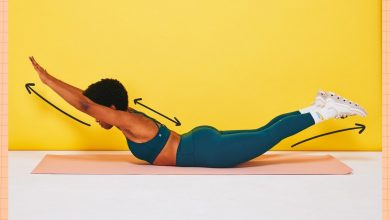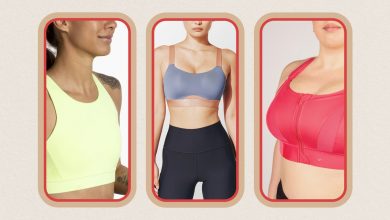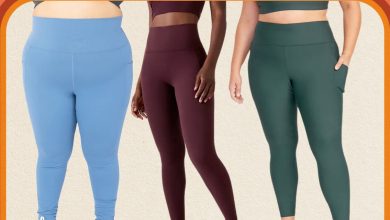9 Expert-Approved Squat Racks That Will Give Your Home Gym a Lift

Our fave features: Our tester loves that PRX doesn’t sacrifice durability or stability to make this rack fold so well—its top-of-the-line 3×3 uprights are made from heavy duty 11-gauge steel, and the steel wall attachments work well to keep the rack firm in place. It also uses Westside hole spacing, meaning it uses strategic 1- or 2-inch spacing throughout the machine for optimal adjustability. Our tester adds that he’s a fan of the quality finish on the machine: “I think the powder coats are top notch.”
Other winning options: PRX does offer a slightly cheaper version featuring 2×3 uprights and an option with a kipping bar (which is a pull-up bar specifically designed for the kipping pull-ups commonly incorporated into CrossFit workouts).
Dimensions: 53″W x 89″ or 95″H | Weight capacity: 1,000 lbs | Frame material: 11-gauge steel | Hole size: ⅝” | Hole spacing: Westside | Warranty: 10-year
Best Half Rack: Rogue H2 Half-Rack
Rogue H2 Half-Rack
Pros
- High-quality construction and finishes
- Compact
- Two height options
- Lifetime warranty
Cons
- Attachment capabilities are limited by lack of modularity and space
- Safety set costs extra
Why we picked it: A half rack is a more compact version of a full squat rack, Artzi says, making it a good option for a home gym because it takes up less space without compromising key qualities like being able to support substantial weight. If you’re mostly interested in compound movements like squats, bench presses, pull-ups, and overhead presses, this smaller rack should work well for you. Our tester liked the Rogue H2 so much that he was tempted to add it to his own home gym. “It’s a beast with a small footprint,” he says, in reference to its durable 3×3, 11-gauge steel uprights finished with a scratch-resistant powder coat. “I truly love this rack.”
Our fave features: You can choose between two height options and add on a pull-up bar, bench, and plates if you like. Our tester is also a fan of how stable this machine is when in use. “I loaded over 550 pounds on it and shook it all around, and the thing did not budge,” he says.
Just so you know: The H2 Half Rack isn’t super modular, so it’s not as easy to add on a variety of attachments (beyond the aforementioned bar, bench, and plates). “If you wanted to have the ability to add a lat pulldown and low row attachment, you would not be able to do that very well with this rack,” our tester says. Instead, check out the options from REP Fitness and ForceUSA.
Dimensions: 49″L x 48″W x 70″ or 92.25″ or 110.25″H | Weight capacity: 1,000 lbs | Frame material: 11-gauge steel | Hole size: ⅝” | Hole spacing: Westside | Warranty: Limited lifetime warranty
Benefits of using a squat rack
Not sure if you need or want a squat rack? Here, Artzi unpacks the four major benefits of adding one to your home gym:
Squat racks support a range of movements, helping you engage different muscle groups in multiple ways and keep your workouts fresh and effective. “A squat rack allows you to perform a wide variety of exercises beyond squats, such as bench presses, deadlifts, overhead presses, TRX anchor and push ups [or] pull-ups, depending on the rack,” says Artzi.
Artzi says squat racks also tend to be safer to use at home than heavier free weights (particularly when you’re working out with a spotter). “With safety arms or spotter arms, a squat rack provides support during heavy lifts, reducing the risk of injury when lifting alone,” she says.
Another advantage of squat racks is that they support progressive overload, meaning they allow you to gradually increase the weight on your muscles to promote continuous strength gains. “Squat racks enable you to [gradually] increase the weights you lift, helping you build strength and muscle over time,” says Artzi.
Specifically, squat racks make it easier for you to test your limits or increase your loads more safely than free weights due to features such as safety pins and spotter arms. Squat racks also allow for a wider range of exercises than free weights, which can help you target various muscle groups to progressively overload more effectively. And squat racks offer a consistency that’s hard to replicate with free weights—you can return to the same setup every time, eliminating variables in your lifts.
You can’t beat the convenience of a home gym that will actually get you fit. “Owning a squat rack at home saves you time and eliminates the need to commute to the gym,” says Artzi. “You can work out on your schedule without waiting for equipment to become available.”
How to pick the best squat rack for you
With so many squat racks on the market, the options can be overwhelming. Before buying your rack, here are some factors Artzi suggests considering:
Lifting goals
If you’re lifting heavy or plan to in the future, Artzi says it’s best to invest in a durable, mid-range or higher-end rack. This will ensure the rack you choose can safely support your weight goals and won’t limit your gains, since less-expensive racks tend to have lower weight capacities.
Space
Some squat racks, like wall-mounted racks, can save space, says Artzi, while others include so many features (like pull-up bars, cable systems, and low row attachments) that your squat rack becomes a near-total gym on its own. Which type you choose may depend on the amount of room you have in your home workout area.
Safety
If you plan to lift alone, says Artzi, you may want to look for a rack with premium safety features, such as spotter arms (which give you a place to safely rest a barbell mid-squat).
Durability
If you see yourself lifting for the long run, Artzi says you may want to future-proof your purchase by investing a larger amount of cash on it from the jump. “Spending a little more up-front can save you from needing to upgrade as you progress in strength,” she says.
Squat specs
Understanding certain squat rack specs can also help you pick the best option for your needs.
Uprights are the large steel posts on a squat rack. They come in three standard dimensions: 3×3 inches, 2×3 inches, and 2×2 inches—with 3×3 being able to support the most weight safely while keeping the frame stable. Slightly smaller are 2×3 uprights, and then 2x2s, which are usually found on more inexpensive machines.
Hole spacing refers to the distance between the center of each hole on an upright (to which you can add weights and other attachments). Most squat racks feature one of three standard hole spacings: 2-inch, 1-inch, or “Westside spacing,” a combination of the two.
Spacing is what allows you to adjust the barbell height to match your individual needs for exercises like bench presses and squats. The closer the spacing, the more precisely you can set the bar, which enhances safety and helps you better customize your lifts based on your body size. In contrast, larger gaps between holes can result in compromised form and increase the risk of injury. The hybrid option of Westside offers 1-inch spacing in the bench-press zone, where precise barbell height adjustments are most critical, and 2-inch spacing throughout the rest of the upright.
This metric affects the compatibility of attachments, such as J-cups, spotter arms, dip bars, and pull-up bars. If the attachments’ specs don’t match the rack’s hole size, they won’t fit properly or may be less secure. Attachments should fit snugly in the holes to ensure they don’t wobble or shift during a lift, especially under heavy loads. The most common hole sizes are ⅝-inch and 1-inch.
Weight capacity generally refers to the amount of weight the J-Hooks on a machine can hold, which impacts how much you can lift.
How we tested these squat racks
Our experienced testers used SELF’s full fitness-testing methodology to rate these squat racks. Here are three areas, in particular, we kept in mind:
No one wants to shell out hundreds of dollars on fitness equipment only to have it fall apart after a few sweat sessions. Durability (and by extension, quality!) is especially important when it comes to squat racks because heavy weight lifting can be dangerous. Our testers assessed how well each product supported different body weights and sizes, and whether the rack wobbled or rocked while using it.
The ACE factor refers to adjustability, customization, and ergonomics. If you’re buying a squat rack, you likely plan to use it for a variety of strength-training exercises and need it to stay safe and effective for all. So we looked for machines that were compatible with a number of attachments. We took note of which racks came with extra customization options, like adjustable height or depth, the ability to add a bench, foldability, and more.
If you’re buying a squat rack for your home gym, space is probably a concern. It’s important to understand the exact dimensions of a machine so you’ll know it’ll fit in your garage or guest room. Our testers looked for machines that can adapt to fit a variety of different spaces thanks to features like adjustable heights, modular designs, and folding capability.
What is the best type of squat rack?
There are several different rack forms, including power racks, squat racks, half racks, wall-mounted racks, Smith machines, and squat stands. “The best form of squat rack depends on your specific needs, space, and fitness goals,” says Artzi.
Think of this like a squat rack, plus. “A full power rack has four posts, making it the most stable and safe option for heavy lifting,” says Artzi. “It comes with safety spotter arms, pull-up bars, and can be used for a wide variety of exercises beyond squats, like bench press, deadlifts, and pull-ups.”
“A half rack is a smaller, more compact version of the full power rack,” says Artzi. “It still provides safety features like adjustable spotter arms and can hold substantial weight, making it a great balance between functional and space-saving.”
Folding wall-mounted rack
“A wall-mounted rack can fold up when not in use, saving significant space. It still provides strong stability when unfolded and can hold decent weight,” says Artzi. “Wall-mounted racks are great for home gym setups in tight areas like garages or small rooms.”
“Squat stands are [often] the most affordable and compact option,” says Artzi. “They’re great for light to moderate lifting and can be moved around easily. Some squat stands come with safety arms, but they aren’t as stable or versatile as full or half racks.”
“The Smith machine has a fixed barbell within a guided track, providing extra safety and control for people who are new to lifting or prefer support during exercises,” says Artzi. However, she notes that Smith machines limit the natural range of motion and aren’t necessarily as effective for building functional strength as the other machines on this list.
FAQs
Don’t have time to read a novella on squat racks? Take a quick peek at our answers to some of the most frequently asked questions about this popular piece of equipment instead.
Is it worth buying a squat rack?
If your fitness goals include serious strength training, and you want to be able to engage in a variety of exercises safely from home, a squat rack may be a good investment. Most racks will enable you to do everything from squats to deadlifts and beyond, and they offer a safe way to get those gains without always needing a spotter. Squat racks tend to be durable as well, and many can grow with you as you progress in your fitness journey—all of which means your initial investment likely won’t have to be replaced for a long, long time.
How much should you spend on a squat rack?
The amount you should spend on a squat rack depends on your budget, space, and fitness goals, says Artzi. Lower-budget options in the $200 to $400 range—such as the ForceUSA MyRack Modular Power Rack or the Titan Fitness T2 Rack—are ideal for beginners and those short on space. That said, they typically have lower weight capacities and fewer features. Mid-range racks, priced between $400 and $800—such as the Ritfit PSR05 2.0 or the Torque Fitness Customizable Squat Rack—are better suited for intermediate to advanced lifters, offering more versatility, safety features like pull-up bars and safety arms, and the ability to handle heavier weights. Premium racks, priced over $800—such as the REP Fitness PR-5000 Power Rack or the Bells of Steel Manticore Six Post Power Rack Builder—provide a heavy-duty setup with multiple attachments, perfect for serious lifters or anyone seeking a durable, versatile rack capable of supporting substantial weight.
What are some things to consider when choosing a squat rack?
When deciding between various squat rack models, Artzi says it’s important to consider your lifting goals first and foremost. If you plan to lift heavy, you’ll want to choose a more premium machine built to shoulder the weight. You’ll also want to think about the amount of space you have for the machine; some are designed to save space, while others are more complex and will take up quite a bit of real estate.
If you plan to work out alone, you’ll want to consider the safety features offered by each model, too. And finally, you’ll want to take your budget into account, as well as how long you see yourself utilizing the machine.
How much can a squat rack hold?
The weight capacity of a squat rack depends on the type and quality of the rack and can vary quite a bit, says Artzi. With that said, here are some general guidelines, according to the pro trainer:
- Full power rack: Typically holds between 500 to 1,000 pounds, but can exceed 2,000 in some cases
- Half rack: Usually supports between 500 to 700 pounds, but higher-end models may support 1,000 pounds
- Squat stand: Generally holds between 300 to 600 pounds
- Smith machine: Typically ranges from 600 to 800 pounds, depending on the manufacturer and model, but some high-end commercial models can handle 1,000 pounds or more
- Wall-mounted rack: Usually supports 500 to 1000 pounds depending on the brand and model, but higher-end options can support up to 1000 pounds
What is the best squat rack for home?
“If you have the space and budget, a full power rack is often considered the best choice for most serious lifters due to its versatility, safety features, and ability to support heavy loads and a wide range of exercises,” says Artzi.
Are cheaper squat racks safe?
Artzi says cheaper racks can be safe, but this depends on a few factors. For starters, the rack needs to have the proper weight capacity to meet your needs. It should also include safety features such as spotter arms and safety bars, and it should have a stable base. “Some budget racks can wobble or tip if not properly designed or if the base is too light,” says Artzi. “Look for options that either bolt to the floor or have a wide, stable frame.”
Related:



